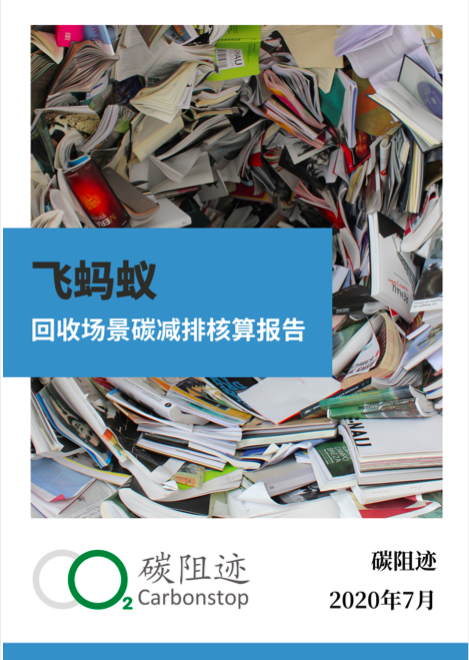Carbonstop calculates the carbon emission reduction in recovery scenario for flying ants
Recently, Carbonstop and Flying Ant worked together to calculate the carbon emission reduction of recycled clothes, used books and home appliances respectively. Flying Ant is a platform that advocates zero abandonment of unused clothes and environmental protection and public welfare disposal of used clothes. The platform adheres to the concept of "environmental protection for the world, public welfare for you". Residents can recycle green beans through the platform, which can be used to donate public welfare projects and exchange environmental benefits. The whole society is encouraged to participate in the action of "idling and zero abandonment".
Recently, carbonstop calculates the carbon emissions of flying ants in their main scenes. The conclusion is as follows, after flying ant platform:
Used clothing recycling, resulting in a reduction of 5.38KgCO2e/kg
Used book recycling, resulting in a reduction of 0.8358KgCO2e/kg
Home appliance recycling, the average emission reduction is 13.27kgCO2e/ unit


Used clothes recycling
The fashion industry produces about 10 percent of the world's carbon emissions, while textile production alone is estimated to produce about 1.2 billion tonnes of greenhouse gases a year. With the emergence of fast fashion, more and more clothes are produced, selected and then forgotten or even discarded.
There are several main ways to dispose of used clothing collected by flying ants:
Environmental regeneration: processing for other materials, such as agricultural insulation materials, construction industry sound insulation materials, recycled cloth, etc.
Public donation: Clothes that meet the donation standards shall be handed over to public welfare organizations or foundations for cleaning and disinfection and then donated to poor areas or public welfare organizations and individuals.
Used clothes export: part of the summer clothes after cleaning and disinfection to the relevant takeout companies exported to Africa, Southeast Asia and some other poor countries.
Environment-friendly recycling: the fibers and fabrics made from recycled clothing are only used as environment-friendly bags, storage boxes, gloves, cushions and other products.
The emissions of clothing have a lot to do with the materials they are made from, the process they are made from and the type of clothing they end up in. The same clothing style, color and size, because different clothing materials will have different carbon footprints. Considering that the style of clothing is updated quickly, it is more scientific to estimate the emission proportion of different types of clothing from the proportion of clothing materials, and effective data can be found.
In the calculating, according to the National Bureau of Statistics data, and related industry association,we respectively find the cotton, wool, silk, linen, viscose fiber and polypropylene, polyester, acrylic, nylon these major common material production or consumption of fabric, and considered as a second-hand clothes (donations and export), open loop recovery (recovery) for different products and closed loop recycling (recycling) for similar products different emissions of the three conditions, as well as fly ants in proportion to the actual recovery to calculate the old clothes recycling the final emission reductions for 5.38 kgCO2e/ kg.
Used book recycling
With the rapid development of electronic devices and e-books, our need for physical books may decline a little. But the disposal of books is still a problem. It is wasteful to throw them away and it is a pity to sell them as paper. The flying ant platform can properly dispose of books. Donation, circulation and sharing library are the first echelon of book disposal, and the remaining invalid books are the way to dispose of ordinary books.
Considering the recycling donations, circulating and Shared libraries are reduced emissions of old waste processing stages and emissions of a new book raw material and processing engineering, so paper, ink, water, additives, PS version, glue, plastic, preparing, collecting, writing, design, image editing, proofreading, binding, are taken into account, and the incineration and landfill of paper, the final conclusion is that the carbon emissions can be reduced by 0.8358kgCO2e per used book on average.
Home appliance recycling
The data availability of electrical appliances recycling part is poorer, although there are some standards and requirements, such as recycling waste electric and electronic products and general technical specifications, waste electrical electronic products recycling, waste electrical appliances dismantling pollution control guideline renewable resource productivity, electronic products use value, waste comprehensive utilization of resources evaluation specification of the television, the disassembly steps and evaluation method for product disassembly and, also in the ground to create modern system of data information. However, less effective data can be obtained, and because different types of electrical appliances differ greatly, the actual dismantling process and the amount of dismantled products also vary.
In the calculation,four types of electrical appliances are included, air conditioners, washing machines, refrigerators, TV.
And the main products after dismantling, which is also the main metal materials used in the production stage of home appliances, such as iron, copper, aluminum and other primary materials smelted from the emissions were compared, and the reduction of unit weight of different types of home appliances due to recycling was obtained. Then according to the average weight of different household appliances, the average emission reduction estimate of this category of household appliances is obtained.
According to the recycling proportion of different household appliances, the weighted result shows that the emission reduction caused by the effective recycling of the main recyclable part of metals in an average household appliance is 13.27 kgCO2e/unit (refrigerant recycling is not included in this value).


